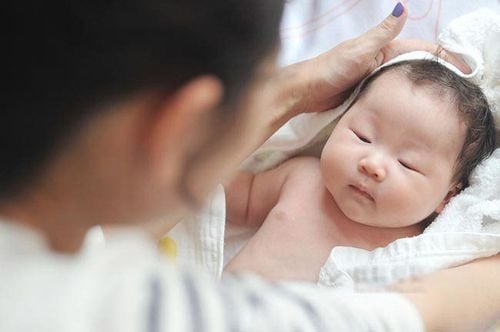This is an automatically translated article.
Breast abscess is a fairly common disease, most common in breastfeeding women because breast milk can cause cracked nipples, allowing bacteria to easily enter the breast. Breast abscess, if not diagnosed and treated promptly, can lead to dangerous complications such as breast necrosis, affecting milk quality, sepsis, especially leading to cancer. Therefore, when there is a breast abscess, it is necessary to make an incision in time to avoid infection.
1. What is a breast abscess?
Breast abscess is usually a complication of mastitis, an inflammation and infection of the breast tissue. The cause of inflammatory breast disease and breast abscess is the entry of bacteria into the breast tissue through the nipple, causing the milk ducts to become infected, causing blockage and inflammation of the milk glands.
Two types of bacteria Staphylococcus aureus and Streptococcus are the most common causes of breast abscess. In addition, other causes such as anaerobic bacteria, typhoid bacillus and blockage of ducts in the nipple due to scarring can also cause breast abscess.
There is a risk of breast abscess appearing if the mother is breastfeeding due to improper breastfeeding; Feeding not enough times, not enough time causing milk to accumulate in the breast, wearing a tight bra, scratched nipples, blocked milk ducts.

Vi khuẩn là một trong những nguyên nhân gây bệnh áp xe vú
2. Signs of a breast abscess
Symptoms depend on the location and stage of the disease:
In the inflammatory stage: The disease usually has a sudden onset with high fever, fatigue, headache, and insomnia. Pain deep in the mammary gland, which increases with movement of the shoulder or arm. Expression at the site of breast inflammation, swelling, firm density, swollen lymph nodes in the armpit on the same side, swelling and pain. The skin above the inflammatory site is normal if the inflammation is deep in the gland or hot, red, and edematous if the inflammation is located just under the skin or on the surface of the gland.
Abscess formation stage: There is one or more abscesses located in one or more different lobes of the mammary gland. At this time, all the symptoms of the inflammatory phase are aggravated: the syndrome of infection, intoxication such as high fever, chills, dry lips, dirty tongue. The skin on the breast is often hot, tight, red, or purple edema.
3. What to do if you have a breast abscess?
Depending on the location and size of the abscess, there are different treatment methods. In principle, when an abscess has formed, it is necessary to operate the breast abscess (incision, draining the pus).
For superficial abscesses under the skin, areola: Treatment is the same as for boils elsewhere. For glandular abscesses: Under general or local anaesthesia, inject the abscess along the spokes at the lowest point above the abscess area. The length of the incision is from 7-10cm, the distance from the nipple is from 2 to 3cm. Use your finger to insert the pus into the pus cavity to break all the fibrous septa. With the above incision, if it is difficult to drain the pus because the abscess has many foci, a second incision can be made. After draining the pus, it is necessary to place a drainage with a rubber tube or gauze. After surgery, it is necessary to pump the abscess daily through the drainage tube with an antiseptic solution, combined with systemic antibiotics. When the incision to drain the pus is not wide enough, the pus may become trapped and the inflammation will spread to the adjacent lobes. With abscesses behind the gland: Need to make an incision to drain the pus in an arc at the lower border, outside the mammary gland. After injecting to drain the pus, it is necessary to place a drainage tube or gauze. It is necessary to wash the abscess daily with easy antiseptic solutions to facilitate the faster healing of the abscess. Note when incision of abscess:
Initial treatment with systemic antibiotics, nutrition to improve the condition until the abscesses are localized into pus-filled foci. Abscesses located superficially under the skin can rupture on their own and drain a white, pus-like fluid. Deep-seated abscesses can't burst and drain pus out, the bacteria in the abscess can spread to the blood vessels, to other parts of the body, causing serious life-threatening complications. such as blood infection, kidney failure ... These cases, if not treated well or the patient does not respond to treatment, can die. Therefore, it is necessary to make an incision in time to avoid infection. Do not apply some folk ways that easily increase the risk of infection and adversely affect health. Only aspirate a ripe abscess (that is, completely pus), not a young, unripe abscess. The nine abscesses show: The inside is a bit stinging, itchy. The surface of the skin where it can be poked turns pale, wrinkled and scaly... and around that area is a pale mangosteen purple. An ultrasound should be performed immediately before the puncture or 1-2 days before the incision to assess whether the abscess has completely turned pus.

Tiến hành rạch áp xe theo đúng quy trình và hợp vệ sinh
4. Steps to perform an abscess incision
Disinfect the abscess area from the inside out, Use a sterile towel to wrap around the procedure area. Identify the abscess, find the softest skin. Incision of the skin just above the abscess is made diagonally across the spokes centered on the nipple. After making an incision through the skin and subcutaneous tissue, go straight to the abscess to avoid crushing surrounding tissues and causing bleeding. Use small forceps or the tip of your index finger to break the walls of the communicating abscess to allow pus to drain. Leave the skin open, place a small gauze in the abscess to drain the pus, withdraw after 12 hours. Monitor for complications after the incision of the abscess such as: bleeding at the skin incision or in the abscess: suturing the bleeding site and continuing to use antibiotics; No pus draining: reopen the catheter, use injectable antibiotics.
5. Prevention of breast abscess
Women who want to avoid breast abscess during breastfeeding should apply the following measures:Maintain good hygiene of the breast and nipple area before and after breastfeeding. Avoid scratching and cracking nipples while breastfeeding. Learn the early symptoms of mastitis, breast abscess... so that you can go to the doctor soon. Breastfeeding should be done at each breast, if the baby has not finished suckling, then express milk to avoid stagnation of milk, milk blockage that is easy to get an abscess. Women with breast abscess who have undergone surgical incision to drain pus should rest and have appropriate nutrition for the wound to heal quickly.
If you have unusual symptoms, you should be examined and consulted with a specialist to avoid dangerous complications.
Vinmec International General Hospital is one of the hospitals that not only ensures professional quality with a team of leading medical doctors, a system of modern equipment and technology, but also stands out for its medical examination and treatment services. comprehensive and professional medical consultation and treatment; civilized, polite, safe and sterile medical examination and treatment space. Customers when choosing to perform tests here can be completely assured of the accuracy of test results.
Any questions that need to be answered by a specialist doctor as well as customers who want to be examined and treated at Vinmec International General Hospital, please register for an online examination on the Website for the best service.
Please dial HOTLINE for more information or register for an appointment HERE. Download MyVinmec app to make appointments faster and to manage your bookings easily.













